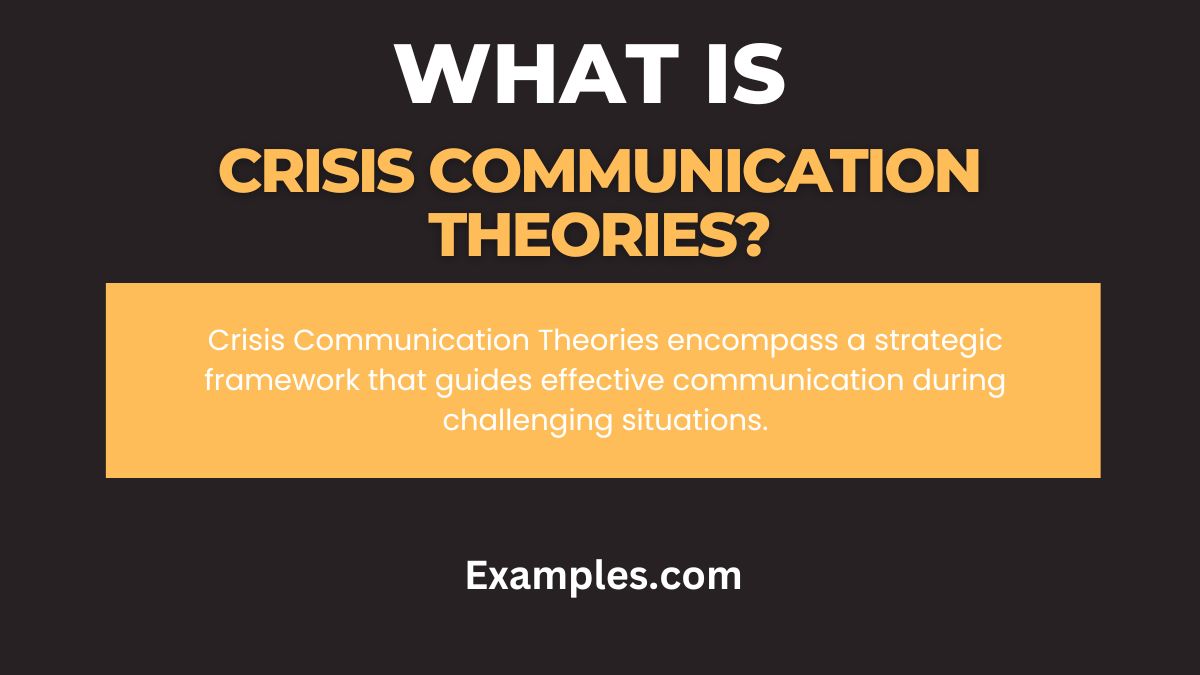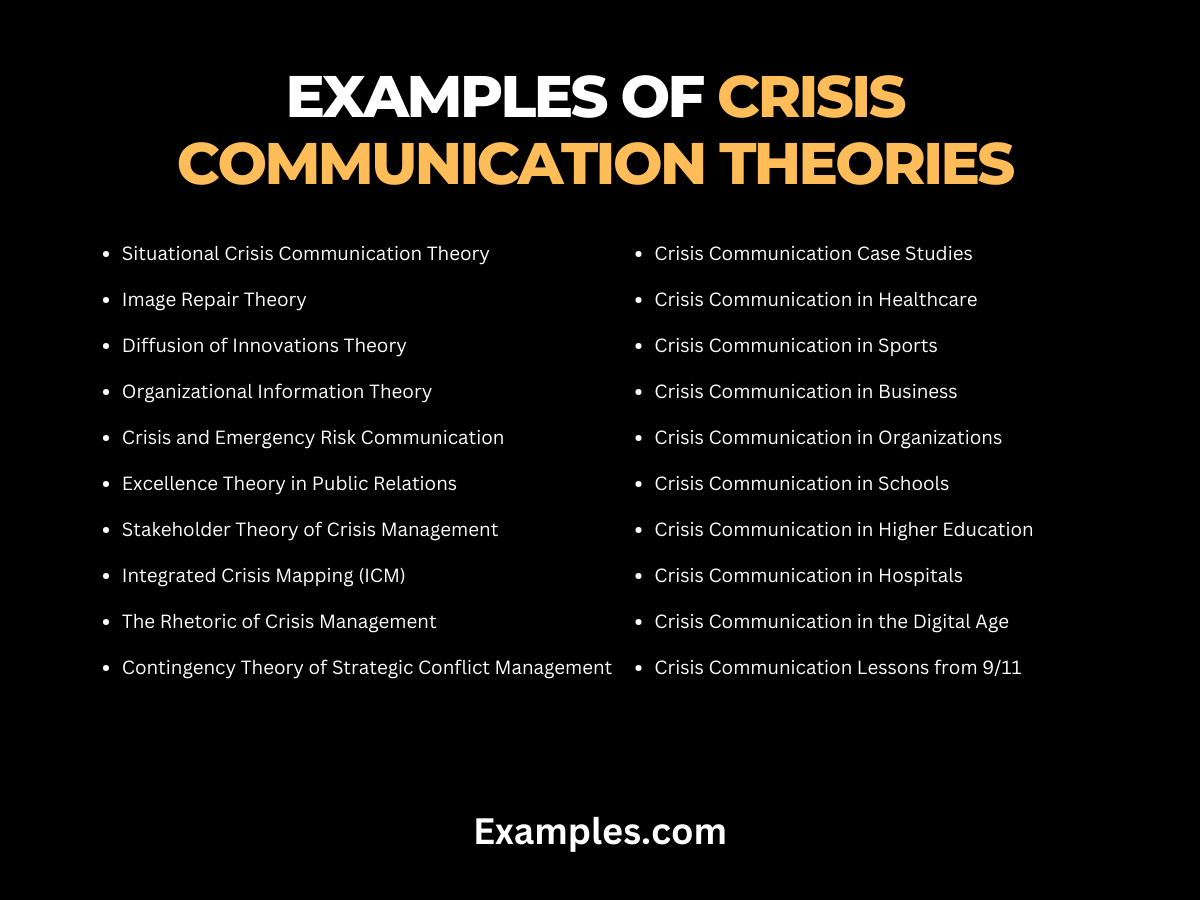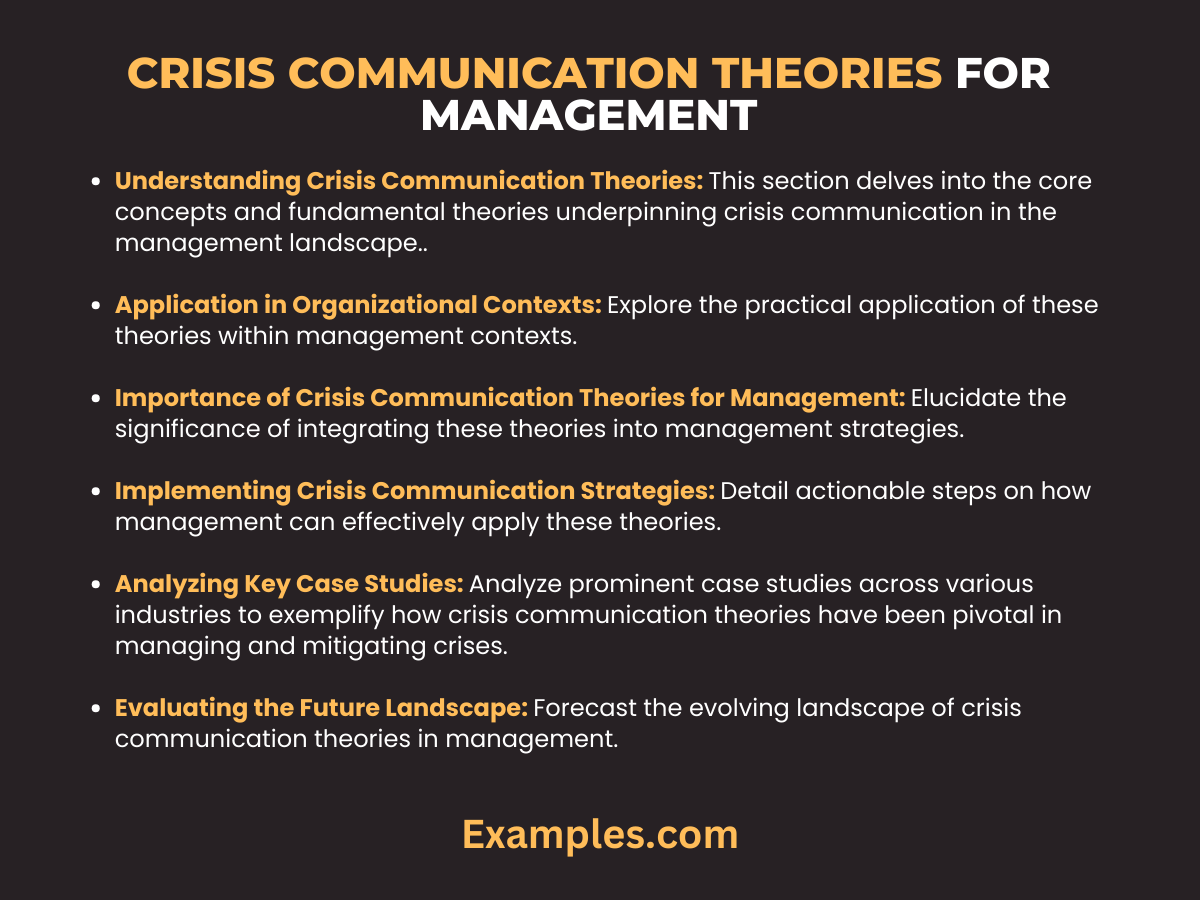19+ Crisis Communication Theories Examples
Embark on a journey through the dynamic landscape of Crisis Communication Theories. Uncover the comprehensive definition, trace the historical origins, and explore the evolution of these pivotal theories. This insightful guide goes beyond the surface, providing actionable tips on mastering crisis communication. Delve into real-world examples to contextualize these theories and discover effective approaches on how to navigate and thrive in challenging scenarios. Elevate your crisis management prowess with invaluable insights and expert tips.
What is Crisis Communication Theories?

Crisis Communication Theories encompass a strategic framework that guides effective communication during challenging situations. In simple terms, these theories provide principles, skills, and approaches to navigate and manage crises successfully. Rooted in understanding human behavior, media dynamics, and organizational responses, these theories serve as invaluable tools in crafting responses that maintain trust, transparency, and resilience during tumultuous times.
20 Examples of Crisis Communication Theories

Crafting a comprehensive list of Crisis Communication Theories examples emphasizes diverse strategies deployed by organizations:
- Situational Crisis Communication Theory (SCCT): Utilizing pre-established response strategies based on the severity of a situation to maintain stakeholder trust.
- Image Repair Theory: Employing corrective actions to rebuild reputation post-crisis, exemplified by Toyota’s recall strategy.
- Diffusion of Innovations Theory: Introducing crisis strategies innovatively, akin to Airbnb’s proactive safety measures during crises.
- Organizational Information Theory: Maintaining accurate and timely information flow during crises, evident in Boeing’s transparent communication post-737 Max crisis.
- Crisis and Emergency Risk Communication (CERC): Providing guidelines and directives during public health crises, akin to CDC’s COVID-19 communication strategies.
- Excellence Theory in Public Relations: Emphasizing ethical communication and stakeholder engagement, showcased by Patagonia’s environmental crisis responses.
- Stakeholder Theory of Crisis Management: Prioritizing stakeholder needs during crises, as demonstrated by Microsoft’s swift communication during security breaches.
- Integrated Crisis Mapping (ICM): Utilizing data mapping to assess and respond to crises, as seen in Google’s crisis response algorithms.
- The Rhetoric of Crisis Management: Deploying persuasive communication during crises, akin to Apple’s crisis communication addressing battery-related issues.
- Contingency Theory of Strategic Conflict Management: Tailoring strategies based on the nature of the crisis, exemplified by Amazon’s crisis responses, adaptive to diverse crises.
- Crisis Communication Case Studies: Exploring successful crisis management cases, such as Coca-Cola’s response to product tampering.
- Crisis Communication in Healthcare: Examining crisis communication models, like the Red Cross’s response to health crises.
- Crisis Communication in Sports: Learning from crisis strategies, evident in the NBA’s crisis responses during player controversies.
- Crisis Communication in Business: Studying crisis communication in corporate settings, reflected in Volkswagen’s response to emissions scandals.
- Crisis Communication in Organizations: Assessing communication strategies in organizational crises, as observed in the United Airlines’ crisis response strategies.
- Crisis Communication in Schools: Addressing crises in educational settings, seen in Harvard University’s response to administrative scandals.
- Crisis Communication in Higher Education: Examining communication strategies in university crises, such as Penn State’s response to controversy.
- Crisis Communication in Hospitals: Studying crisis responses in healthcare institutions, like the Mayo Clinic’s crisis communication strategies.
- Crisis Communication in the Digital Age: Adapting communication strategies in digital crises, seen in Facebook’s responses to data breaches.
- Crisis Communication Lessons from 9/11: Learning from historic crises, such as FEMA’s crisis communication during the 9/11 attacks.
Crisis Communication Theories For Management

Crisis Communication Theories for Management encapsulate diverse strategies to navigate challenging situations effectively. These theories provide frameworks guiding organizational responses during crises. Here’s a comprehensive guide:
Understanding Crisis Communication Theories: This section delves into the core concepts and fundamental theories underpinning crisis communication in the management landscape. It introduces pivotal theories like Situational Crisis Communication Theory (SCCT), Image Repair Theory, and Stakeholder Theory of Crisis Management.
Application in Organizational Contexts: Explore the practical application of these theories within management contexts. Highlight how organizations integrate these theories into crisis preparedness, response, and recovery. Showcase case studies illustrating successful implementation and the impact on decision-making.
Importance of Crisis Communication Theories for Management: Elucidate the significance of integrating these theories into management strategies. Discuss the value they add in fostering stakeholder trust, maintaining brand reputation, and reducing the impact of crises on organizational operations.
Implementing Crisis Communication Strategies: Detail actionable steps on how management can effectively apply these theories. Provide insights into crafting crisis communication plans, training management teams, and utilizing theoretical frameworks in real-world scenarios.
Analyzing Key Case Studies: Analyze prominent case studies across various industries to exemplify how crisis communication theories have been pivotal in managing and mitigating crises. Highlight successes and failures to draw insightful lessons for management practices.
Evaluating the Future Landscape: Forecast the evolving landscape of crisis communication theories in management. Discuss potential advancements, integration of technology, and emerging theories shaping crisis management in the future.
Key Takeaways: Summarize key learnings from crisis communication theories for management. Reiterate the significance of these theories and their proactive implementation in contemporary organizational settings.
Situational Crisis Communication Theory
Situational Crisis Communication Theory (SCCT) stands as a pivotal framework in crisis management, emphasizing adaptive communication strategies based on the severity of a situation. Sharpen your communication skills with this in-depth guide:
Understanding SCCT: Delve into the core concepts of SCCT, unraveling its theoretical foundations and how it shapes crisis response strategies.
Key Components of SCCT: Explore the critical elements of SCCT, including crisis severity, attribution of responsibility, and the selection of appropriate response strategies.
Crisis Severity Assessment: Enhance your communication skills in evaluating crisis severity, distinguishing between routine and crisis situations, and tailoring responses accordingly.
Attribution of Responsibility: Master the art of attributing responsibility during a crisis, recognizing how assigning blame impacts stakeholder perceptions and communication dynamics.
Adaptive Response Strategies: Navigate through the various adaptive response strategies proposed by SCCT, such as denial, diminish, rebuild, bolster, and bolster with differentiation.
Real-world Applications: Gain insights into how SCCT has been effectively applied in real-world scenarios, examining successful cases where adaptive communication strategies led to reputation restoration.
Common Challenges and Pitfalls: Refine your communication skills by understanding potential challenges and pitfalls associated with implementing SCCT, ensuring a nuanced approach to crisis communication.
Integrating SCCT with Communication Skills: Discover practical tips on integrating SCCT principles with your communication skills toolkit, fostering a holistic and effective crisis response.
Case Studies: Analyze case studies illustrating SCCT in action, exploring how renowned organizations navigated crises using adaptive communication strategies.
SCCT Training and Development: Boost your communication skills through SCCT-focused training and development programs, ensuring readiness for dynamic crisis scenarios.
Future Trends and Evolving Perspectives: Stay ahead of the curve by exploring emerging trends and evolving perspectives in crisis communication, including advancements in SCCT research.
Mastering Crisis Communication Skills: Cap off your journey with actionable steps to master crisis communication skills, leveraging SCCT principles for a robust and adaptable approach.
Crisis Communication Theories In Business
Crisis communication theories in the corporate landscape play a pivotal role in managing adversities. Here’s a comprehensive guide:
Understanding Crisis Communication Theories: Crisis communication theories in business encompass various frameworks, including the Situational Crisis Communication Theory (SCCT), Image Repair Theory, and Stakeholder Theory. These models assist businesses in devising effective strategies for diverse crises.
Application of SCCT in Corporate Settings: SCCT aids in assessing crisis severity and selecting suitable communication strategies. Analyze SCCT’s practical implications for business crises, emphasizing appropriate responses for different situations.
Image Repair Strategies for Corporations: Explore Image Repair Theory and its significance in restoring the reputation of businesses post-crisis. Examine practical examples from companies employing this theory for reputation management.
Stakeholder Theory Implementation: Delve into Stakeholder Theory’s role in crisis communication. Learn how organizations identify, engage, and address stakeholder concerns during crises, fostering trust and loyalty.
Crisis Communication Plan Development: Integrate these theories into crafting a robust crisis communication plan for businesses. Emphasize the importance of preparedness, accurate messaging, and swift response strategies.
Real-Life Case Studies and Examples: Analyze real-world scenarios where businesses effectively applied these theories. Case studies like Johnson & Johnson’s response to the Tylenol crisis illustrate practical implementations.
Crisis Communication Training and Implementation: Detail how businesses conduct training sessions and workshops to prepare employees for crisis communication. Highlight the importance of simulations and role-playing exercises.
Integration with Modern Communication Tools: Discuss the amalgamation of crisis communication theories with modern communication tools and technology. Emphasize leveraging social media, AI-driven analytics, and real-time response systems.
Situational Crisis Communication Theory and How It Helps a Business
Situational Crisis Communication Theory (SCCT) is pivotal in navigating corporate crises. It offers a structured framework for tailored crisis responses, aiding businesses in managing and mitigating reputational damage during adverse situations.
Key Components of SCCT
- Assessment of Crisis Severity: SCCT categorizes crises based on severity, enabling businesses to match responses to the intensity of the situation.
- Response Strategy Selection: It outlines strategies for effective crisis response corresponding to the crisis severity level identified.
- Impact on Reputation: SCCT emphasizes gauging how different responses can impact an organization’s reputation during crises.
Application in Business Scenarios
- Proactive Crisis Preparation: SCCT assists in proactive planning, ensuring businesses are equipped with pre-designed response strategies for potential crises.
- Adaptive Communication: It allows businesses to tailor communication based on the crisis severity, addressing stakeholders with relevant and impactful messaging.
- Reputation Management: SCCT aids in safeguarding the company’s reputation by guiding the choice of responses that mitigate negative perceptions.
Implementing SCCT in Real-time
- Training and Preparedness: Train crisis teams to swiftly assess crises using SCCT’s severity scale, enabling prompt and well-tailored responses.
- Adaptive Messaging: Use SCCT principles to craft adaptable communication strategies for different crisis scenarios.
- Monitoring and Adjustment: Continuously monitor the crisis landscape and refine responses based on evolving situations, leveraging SCCT’s adaptive nature.
Benefits for Business Communication
- Reputation Preservation: SCCT minimizes reputational damage through strategic crisis communication, safeguarding brand equity.
- Enhanced Stakeholder Trust: Tailored and appropriate responses foster trust among stakeholders by showcasing preparedness and sincerity.
- Crisis Resolution Efficiency: SCCT streamlines crisis responses, enhancing the effectiveness and efficiency of crisis management.
In conclusion, mastering Crisis Communication Theories is a strategic imperative for any organization. From Situational Crisis Communication Theory (SCCT) to Image Repair and beyond, these theories provide a roadmap to navigate the intricate landscape of crises. By integrating these theories into your communication strategy, you fortify your ability to respond effectively, preserve reputation, and emerge resilient in the face of adversity.



